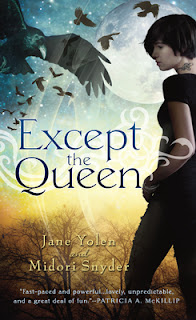This is a huge topic; here’s the tip of the proverbial
iceberg that I can see, and why you should maybe care.
The idea to write about this came up when I did my little
study, short and flawed as it was, to find out if people are still buying fairy
tales in any quantity (see "
Do people still read fairy tales?"). What I found was a little surprising: Grimm outsells
everybody. The Complete Grimm that Barnes & Noble puts out was ranked at
155 on their top seller lists in early January 2012. No other fairy tale book that I could
find even came close to that.
So what’s the lesson there? Could be a lot of things, but I
think you have to acknowledge Grimm’s appeal. What does Grimm do well? One
thing that, I suspect, rings true is that these particular stories believe in
good and evil. I know that’s not fashionable, but it’s true. Let me give one
example.
I doesn’t get much starker than in “The Juniper Tree.” The
villain, a stepmother who craves her husband’s property for her daughter
instead of the dead wife’s son, allows what the story calls an “evil” thought
to overpower her and cuts the boy’s head off. As if that’s not bad enough, she
manages to get her daughter (whom she presumably loves less than her own skin)
to think she (the daughter) killed the boy. Then she cooks the boy in a stew,
which the unwitting, good-hearted father devours with a rare appetite.
So this is evil—sharp, well-defined evil. Far-fetched? A
little, maybe. But I’ve seen the evening news. Enough said.
Unlike in normal life, this evil stepmother is going to get
hers—and how. That’s one thing you know, when you’re reading Grimm. You see all
this unfolding with horror and, even though it’s understated, it’s potent. But
you know it’s somehow coming out well in the end. And it does.
The sister, poor thing, weeping and hysterical, takes the
boy’s bones (removed from the empty stewpot by the stepmother) and buries them
under the boy’s dead mother’s favorite juniper tree. Something magical
happens—you guessed that, right?—and the boy’s bones vanish, a bird appears,
and it flies away and sings a beautiful song, earning itself three strange
objects. At least, so the characters in the story think, though the song lyrics
are terrible. “My mother murdered me, my father ate of me …”
I won’t go through the whole thing. Cut to the happy ending:
the father gets a beautiful gold necklace, the sister gets a beautiful pair of
shoes, and the stepmother gets a millstone on her head. The bird goes back to
being the boy. The end.
There’s even a little more on this line, but that’s enough
to give the gist.
Now, picking up a modern fairy tale, or a modern retelling
of a fairy tale, or a modern fantasy novel (or many other kinds of novels), off
the shelf, you don’t know two things going in: (1) if there’s going to be a
real villain, who’s understandable but still wicked in the old sense of “bad,”
“not good”; and (2) if there’s going to be a “happy ending,” in the sense that
bad people will get punished and good ones will win through. Actually there’s a
third: you don’t know if there’s going to be anybody that’s “good” in the story
either; I mean, a hero you can want to live through it and thrive.
Picking up Grimm, you can basically assume (1) and (2) at
least, and usually you’ll get (3) into the bargain. These aren’t religious
stories; they aren’t “Christian,” for instance. But they are profoundly moral:
they believe in right and wrong. And part of the satisfying nature of them is
this “right and wrong,” good and evil, punishment and reward, quality.
Could it be that people are reading Grimm because they, too,
believe in good and evil, punishment and reward? Seems likely. Crime shows are
among the very most popular on television—especially the ones that believe in
punishments for evildoers, and vindication for victims. They too are profoundly
moral. You might not agree with all of their morals, but they are moral in that
sense.
Whereas what could be more disappointing than spending hours
reading a thick fantasy novel and finding, at the end, that (1) there wasn’t
really any bad guy; or (2) the bad guy wasn’t at all believable; or (3) there
wasn’t any character with a shred of integrity or loyalty (they were all bad
guys); or (4) there wasn’t a good, satisfying outcome (nobody who deserved it
got punished, or won the day)? Grimm will give you most or all of those in just
about every three-to-five page story. That translates to hours of satisfying reading.
But, so this won’t get lost in the
middle, I want to re-emphasize two points about Grimm. One is that few if any
of the heroes are “good” in the sense of being perfect or untouchably moral.
Some are tricksters, clever, almost swindlers. Some are just loyal to
somebody—a small kind of “goodness” that, however, is very powerful in life.
The second point is that the thrill of the stories seems to derive at least
partly from how the magic will be involved—sometimes on the dark side,
sometimes on the light side, sometimes on both. Strange to say, I can feel my
pulse rise even though I know the thing’s going to come out right. Maybe that
shows how naïve I am—me and thousands of others.


